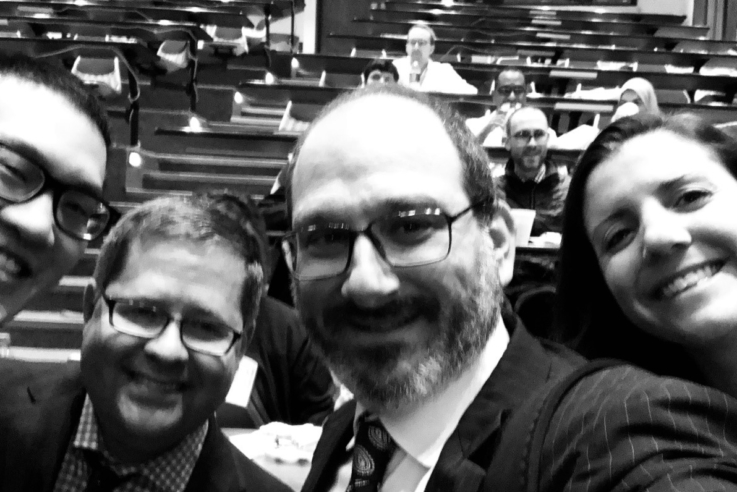
Written by Joel M. Topf,1 Tim Yau,2 Ana Burgner,3 Matt Sparks4 | 1. Division of Nephrology, Department of Medicine, Oakland University William Beaumont School of Medicine, Auburn Hills, Michigan, USA. 2. Division of Nephrology, Department of Medicine, Washington University, Saint Louis, Missouri, USA. 3. Division of Nephrology, Department of Medicine, Vanderbilt University Medical Center, Nashville, Tennessee, USA. 4. Division of Nephrology, Department of Medicine, Duke University, Raleigh, North Carolina, USA.
![]()
Social media is increasingly being used to deliver medical education content. Evidence can be seen with the significant increase in the number of YouTube videos covering every aspect of medicine.1 Twitter has become an important part of the medical education social media conversation. There has been increased usage of Twitter during medical meetings, as attendees reject the role of passive receptacle and actively join in the conversation about the lecture. Crosstalk occurs not only between participants at the meetings, but also between authors, speakers, and interested participants not physically present.2,3,4 Twitter is now a place where the latest literature is promoted and analysed in a thousand small journal clubs, as clusters of people linked by common interests discuss and dissect articles.5,6,7 This post-publication peer review has actually resulted in corrections and retractions.8
NephMadness is a social media project that is very different from the above examples.9,10 When meetings and research articles spark social media interest, the discussion begins outside of the sphere of social media and is then transferred within the sphere. NephMadness is a project that reverses this process, beginning entirely within social media and then expanding beyond the boundaries of social media.
NephMadness, now in its 7th year, is a derivative of the annual USA collegiate basketball championships, colloquially known as March Madness. The cornerstone of March Madness is the bracket: a visual representation of the single elimination tournament modeling the 63 games that allow the tournament to crown a champion in 3 weeks. NephMadness is a social media, online, medical education campaign that is hosted at AJKDblog.org. In place of college basketball teams, NephMadness selects 32 nephrology concepts from 8 academic regions. The regions are determined by the NephMadness Executive Team of four nephrologists from North America. An expert in the region is then solicited to determine four nephrology concepts to represent the region. These experts are called members of the ‘selection committee’.
Once everything is finalised, the NephMadness team writes reviews of all 32 topics in the tournament and arranges them into a single elimination bracket, similar to March Madness. The write ups are vetted, reviewed, and edited by the Editorial Board at AJKD, the region’s selection committee member, the NephMadness Executive Team, as well as the continuing medical education/maintenance of certification (CME/MOC) team at the National Kidney Foundation. Each of the 32 teams has a write-up that is termed the ‘scouting report.’ NephMadness 2019 is composed of the following 8 regions and selection committee members:
- Hypertension, with Susan Steigerwalt
- Exercise nephrology, with Chirag Parikh and Maryam Khosravi
- Hospitalist nephrology, with Charlie Wray
- Volume assessment, with Tariq Shafi
- Hepatorenal syndrome, with Juan Carlos Velez
- Complement mediated diseases and therapies, with Carla Nester
- Pain management in CKD, with David Juurlink
- Plasma exchange in kidney disease, with Andre Kaplan
Once the scouting reports are complete, they are enhanced with visual abstracts and custom graphics. All the write ups are complete with links to primary and secondary literature and exist as open-access resources for future viewing. On the day that the tournament opens, the brackets and the reviews are unveiled to the public. For the first 2 weeks of the tournament, people participate by predicting which concepts will win and advance in the bracket. This is called ‘filling out a bracket’ and is identical to how college basketball fans participate in March Madness. Participants make their predictions on a custom website and can join as individuals and as a part of a team. Teams can be residency or fellowship programmes, departments, practice groups, or any other loose collection of individuals. In 2018, the largest group was from listeners of the internal medicine podcast, The Curbsiders.
In order to determine the winners of each matchup, the NephMadness Executive Team selects a Blue Ribbon Panel consisting of nine renowned nephrologists. They vote on all 31 match-ups, taking the tournament from an initial field of 32 to a single champion. The 2019 Blue Ribbon Panel is composed of:
- Mike Choi, past president of the National Kidney Foundation
- Melanie Hoenig, associate professor at Harvard Medical School
- Sarah Faubel, professor at the University of Colorado
- Roger Rodby, professor at Rush University
- Fiona Loud, policy director at Kidney Care UK and kidney transplant recipient
- Eleanor Lederer, professor at the University of Louisville, past president of the American Society of Nephrology
- Deidra Crews associate professor at John Hopkins University
- Mark Okusa, professor and past president of the American Society of Nephrology
- Holly Kramer, professor at Loyola University Chicago and president of the National Kidney Foundation.
After the tournament opens, additional blog articles about the competition are posted at AJKDblog.org. These are invited editorials by experts in the field to provide their perspective on a single concept or to make a judgement on which members of a region will win the hypothetical matchups. This year, patients are being invited to share their experiences in select regions. All of these articles add to the volume of free, open access nephrology education available on the web. In its first 6 years, NephMadness has generated 235 articles.
The real measure of NephMadness is not in the number of articles, but the engagement it captures from the participants. Each year, the number of bracket submissions, Twitter participants, and page views increases successively.11 Another example of participant engagement is the advent of #BlueRibbonFail. In the 4th year of NephMadness, there was an upset in the dialysis region. Over two thirds of the participant entries voted for the topic of ‘depression in dialysis’ to win over ‘Kt/V urea’. Kt/V is the standard of care for measuring the dose of dialysis, but it has a chequered past, with increases in Kt/V urea repeatedly failing to improve patient survival in randomised controlled trials.12,13,14 The Blue Ribbon Panel, in a split 5–4 decision, went with the standard of care, Kt/V. Following this decision, Twitter erupted with discontent and started using the hashtag #BlueRibbonFail to organise their anger. Hundreds of people participated in this revolt against the decision of the Blue Ribbon Panel. The online discussion and debate on this controversy was vibrant and meaningful, as well as entertaining. It is remarkable that a game that is designed for fun, with no stakes, and for an audience of participants interested in nephrology could spark such emotion.
Another aspect of NephMadness which has grown is the participation by residency and fellowship training programmes around the world. The NephMadness Executive Team created a NephMadness-in-a-Box kit for programs to use. It includes a sample email to invite participants to a NephMadness meeting, downloadable brackets to print and supply to the participants, and a PowerPoint presentation that allows a group to work through the brackets during the meeting. Groups then started tweeting pictures of their NephMadness groups. There were pictures of people meeting at restaurants, conference rooms, and in their homes, in groups of large as 30. It was an excellent example of how a social media medical education campaign moved from the online world to the real world and sparked real-time conversation between residents, fellows, and attendings.
NephMadness has emerged to be a unique social media campaign that manages to provide advanced, peer-reviewed, medical information in a way that is engaging. NephMadness creates an emotional attachment for participants during their journey through ongoing medical education.
References
- Tackett S et al. Medical education videos for the world: An analysis of viewing patterns for a youtube channel. Acad Med. 2018;93(8):1150-6.
- Kalia V et al. Leveraging twitter to maximize the radiology meeting experience. J Am Coll Radiol. 2018;15(1 Pt B):177-83.
- Attai DJ et al. Tweeting the meeting: Twitter use at the American Society of Breast Surgeons Annual Meeting 2013-2016. Ann Surg Oncol. 2016;23(10):3418-22.
- Wilkinson SE et al. The social media revolution is changing the conference experience: analytics and trends from eight international meetings. BJU Int. 2015;115(5):839-46.
- Topf JM et al. The evolution of the journal club: From Osler to Twitter. Am J Kidney Dis. 2017;69(6):827-36.
- Roberts MJ et al. Globalization of continuing professional development by journal clubs via microblogging: A systematic review. J Med Internet Res. 2015;17(4):e103.
- Wray CM et al. The adoption of an online journal club to improve research dissemination and social media engagement among hospitalists. J Hosp Med. 2018;13(11):764-9.
- Bloggers correct the New England Journal on ICU decontamination article. PulmCCM. 2014. Available at pulmccm.org/critical-care-review/blogger-peer-reviewers-correct-new-england-journal-mrsa-article/. Last accessed 14 March 2019.
- Sparks MA et al. NephMadness 2015: Nephrology as a cornerstone of medicine. Am J Kidney Dis. 2015;65(3):375-7.
- Sparks MA, Topf JM. NephMadness after 5 years: A recap and game plan for the future. Am J Kidney Dis. 2018;71(3):299-301.
- Burgner A. #NephMadness 2018: Thank You. AJKD Blog. 2018. Available at https://ajkdblog.org/2018/04/18/nephmadness-2018-thank-you/. Last accessed 14 March 2019.
- Eknoyan G et al. Effect of dialysis dose and membrane flux in maintenance hemodialysis. N Engl J Med. 2002;347(25):2010-9.
- Paniagua R et al. Effects of increased peritoneal clearances on mortality rates in peritoneal dialysis: ADEMEX, a prospective, randomized, controlled trial. J Am Soc Nephrol. 2002;13(5):1307-20.
- Palevsky PM et al. Intensity of renal support in critically ill patients with acute kidney injury. N Engl J Med. 2008;359(1):7-20.







